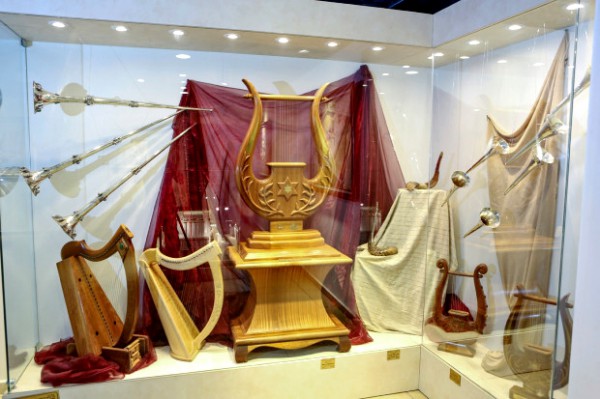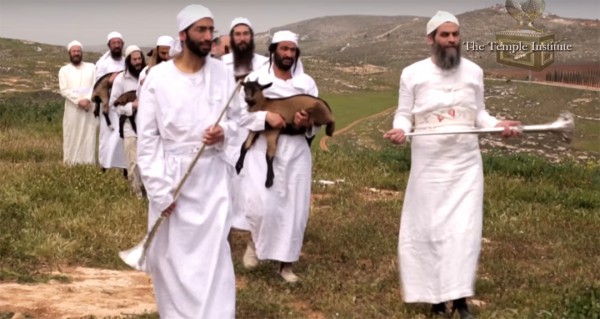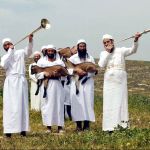The Nezer HaKodesh Institute for Kohanic Studies is teaching Jewish priests to perform Temple service for the Third Temple, which will hopefully soon be rebuilt in the Holy City of Jerusalem.
And science is moving this epic event forward.
As the science of archaeology continues to uncover coins, seals, jugs, arrows, and writings confirming a Jewish presence in Jerusalem during the First and Second Temple periods, so too “genetic archaeologists” are uncovering a continual line of priests beginning 3,300 years ago with the first High Priest (Cohen Gadol), Aaron.
While in the wilderness, God gave instructions to Moses on how to build a Tabernacle where His presence would dwell.
He also instructed Moses to anoint his brother Aaron as the first High Priest who would perform sacred service unto the Lord in the Tabernacle. In doing so, He promised that Aaron’s descendants would also become priests in His service forever:
“Their anointing will be to a priesthood that will continue throughout their generations.” (Exodus 40:15)
Genetic testing of these descendants reveals how incredibly true God’s promise is. In fact, the highest “paternity-certainty” rate of any population ever studied is that of the priestly descendants of Aaron.
Dr. David Goldstein, human geneticist, says, “For more than 90 percent of the Cohens to share the same genetic markers after such a period of time is a testament to the devotion of the wives of the Cohens over the years. Even a low rate of infidelity would have dramatically lowered the percentage.”
Since Aaron and Moses were from the Tribe of Levi, all Cohens are Levites, but not all Levites are Cohens. Let’s examine some of the differences. (In English, there are various ways of spelling Cohen, such as Kohen or Kohan).

“The Levites stood with the instruments of David, and the priests with the trumpets.” (2 Chronicles 29:26)
Temple Service of the Levites
“The duty of the Levites was to help Aaron’s descendants in the service of the temple of the LORD: to be in charge of the courtyards, the side rooms, the purification of all sacred things and the performance of other duties at the house of God.” (1 Chronicles 23:28)
Moses and his brother Aaron belonged to the tribe of Levi, the third son of Jacob and Leah.
While God set aside the descendants of Aaron to be anointed as Levitical priests from generation to generation, He also set aside Levites who did not descend from Aaron to help the priests in their worship and sacrificial duties.
For instance, Levites sang psalms during service, maintained the Temple, and served as guards, among other duties.
In the wilderness, maintaining the Tabernacle involved taking down, carrying, and reassembling the structure and its furnishings as they moved from place to place.

Levitical Priests in training practice the Passover offering (Source: Temple Institute Youtube capture)
Temple Service of the Cohen
“As I will never renege on My covenant with day and night, so is my covenant with … the Levites, the Kohanim, My servants.” (Jeremiah 33:21)
The Tabernacle in the wilderness not only housed God’s presence, it provided a place to perform the sacrificial system that God handed down to Moses in the desert, a system that is totally under the direction of the Cohanim or the priestly class.
The sacrifices were designed to temporarily cover or make appeasement for the sins of the Cohanim and those of the entire nation of Israel, to cleanse each member of the community from their iniquities before man and God.
Throughout the year, the people brought their own sacrifice for their own individual transgressions.
But once a year, on Yom Kippur (the Day of Atonement), the Cohen HaGadol (High Priest) entered into God’s presence inside the Holy of Holies and made atonement for the entire nation of Israel.

Joshua assigned pasture lands outside the walls of 35 cities for the Levites and 13 cities for the Cohen throughout the tribal lands of Israel (Joshua 21).
One might think that God would have given the Levites privileged land as their inheritance to match their privileged position, but God actually gave them no land inheritance at all.
Instead, they received agricultural and monetary tithes from the people as their inheritance, particularly the Maaser Rishon or First Tithe, which was ten percent (Numbers 18:26, 10:38, 18:24).
The Levies and Cohanim lived among the people on pasture land allotted to them by the Israelites outside their city. In this capacity, they raised cattle and had the opportunity to minister to the people through the instruction of Torah.
In Jerusalem, for instance, after returning from Babylonian exile, the Levites translated the Torah, often into the common Aramaic language, and explained it so the people could understand.
“The Levites … instructed the people in the Law while the people were standing there. They read from the Book of the Law of God, making it clear and giving the meaning so that the people understood what was being read.” (Nehemiah 8:7–8)
By the time of Yeshua (Jesus), the Levitical priests had become religious aristocrats holding powerful positions, including the chief priest in the Sanhedrin court.
Though they considered Scripture to be far more important than oral traditions, politics held more power than religion, and many judicial decisions were made in order to keep the peace with the Roman government instead of keeping God’s law.
With this hierarchy firmly in place, they condemned Yeshua and turned Him over to the Romans to be executed.
Since their rule was politically tied, when the Romans destroyed the Temple in AD 70 and the Jewish people were exiled throughout the nations, the authority and influence of the Sanhedrin as well as the Cohen as a ruling class dissolved.
In their absence, the Pharisees who were of multiple tribes and worked in the marketplace among the people, formed a council and rose to power. They continued to thrive, developing traditional Judaism into the religion that exists today.
Although prayer, charity, and repentance have temporarily replaced Temple sacrifices, the Jewish People still long for the rebuilding of a Temple where they will serve the Lord in the Messianic reign to come.
They pray every day “that the Temple be rebuilt speedily in our days…. And there we will serve You in reverence, as in the days of old and as in former years.”
In this effort, various groups such as the Temple Mount Faithful and Temple Institute are proactively preparing for a Third Temple so that priestly service can resume.
A school for priests is the natural result of that effort.

The Nezer HaKodesh Institute for Kohanic Studies trains priests to perform offerings and sacrifices as prescribed in the Torah (first five books of the Bible) (Source: Temple Institute YouTube capture)
Schooling Temple Priests
The Nezer HaKodesh Institute for Kohanic Studies is actively schooling Jewish priests to perform Temple service.
Participants are being drawn from a registry of Cohanim prepared by the school’s parent foundation, the Temple Institute in Jerusalem, which has already created nearly all of the vessels, furnishings, and priestly garments needed in a fully functioning Temple.
To register for study, one must be certified as having a clear patriarchal link to the priestly class, be born and raised in Israel, and have observed the laws of purity required by priests.
Anyone who has made contact with a dead body or has come under the roof of a dead person is disqualified. Therefore, a Jew of Cohen descent who was born in a hospital, has visited hospitals, or has been to a cemetery (except for a close relative) is not eligible.
The school is not only instructing students on the halakha (Torah law) that applies to priestly Temple service but also such specialized topics as “The Role and Application of Modern Technology in the Third Temple” and “The Mathematics of the Holy Temple.” Also included are courses on “Aspects of Engineering and Design” and “The Topography of the Temple Mount.”
This instruction seems to suggest that the Cohanim are involved in the actual design and/or construction of the future Temple.
In fact, this was the case in Jerusalem after the Jews returned from exile in Babylon.
We read in Ezra 1:5 that “the priests and Levites — everyone whose heart God had moved — prepared to go up and build the house of the LORD in Jerusalem.”
And in Ezra 3:8, we learn that the leaders of Israel appointed “Levites twenty years old and older to supervise the building of the house of the LORD.”

A Jewish father pulls his sons (who are each wearing a tallit katan) under his tallit gadol during the Priestly Blessing at the Western Wall in Jerusalem.
Discovering Priestly Descent
“Bring near to you Aaron your brother, and his sons with him, from among the people of Israel, to serve me as priests.” (Exodus 28:1)
The Cohen line is patrilineal — that is, it has been passed down from father to son over the last 3,300 years.
As with the line of David, DNA is not the only way to determine ancestry. One can trace their priestly lineage through family trees, oral traditions, and possessing a common priestly surname, such as the obvious Cohen as well as Kahn and Katz, which stands for Kohen Tzedek (Righteous Priest).
Since AD 1000 when the Jews separated into Ashkenazi and Sephardic communities, Cohanim have adopted a myriad of skin color, eye color, and hair color.
Nevertheless, one Israeli scientist, Dr. Karl Skorecki, a Cohen of Eastern European parents hypothesized that if Cohanim are descendants of one man (Aaron) there should be a common set of genetic markers, a common haplotype that is shared by all male ancestors dating back to Aaron HaCohen.

A descendant of Aaron recites the Priestly Blessing over the congregation at the Western (Wailing) Wall. This is done with the shoes removed, hands washed, head covered with the tallit (prayer shawl), and hands outstretched toward the congregation.
Working with Prof. Michael Hammer at the University of Arizona, a pioneer in Y chromosome research, Dr. Skorecki conducted the first study to test his hypothesis that Cohanim have more specific common genetic markers than the Jewish population in general. The results of this first study were published in the British science journal, Nature.
Of the 106 men who identified themselves as Cohen before the study, 97 of them had six of the same chromosomal markers.
This collection of markers has come to be known as the Cohen Modal Haplotype (CMH), and now serves as the standard genetic signature for helping to determine who is a member of the Jewish priestly family.
While the chance of such markers occurring randomly is greater than one in 10,000, merely possessing the CMH haplotype does not certify a man for Temple Service. This is because tribal identity is derived through one’s father but Jewishness is derived through one’s mother.
If a Cohen’s mother is not Jewish, his status as a priest is stripped. Converting to Judaism does not make him eligible either. (chabad)
Markers have been identified for non-priestly Levites as well, but they can also be pointed out through such surnames as Levy, Levin, or even Lewis.
More than identifying who can serve as a Cohen and Levite in a Third Temple, the genetic markers of the Cohanim are helping scientists hunt for Jewish genes and dispel myths throughout the world as to who is or is not Jewish by descent, especially in relation to the lost tribes.
Discovering Our High Priest: Yeshua HaMashiach
“Since we have a great Kohen Gadol [High Priest] who has passed through the heavens, Yeshua Ben-Elohim (Jesus, Son of God), let us hold firmly to our confessed allegiance. For we do not have a kohen gadol who is unable to sympathize with our weaknesses, but One who has been tempted in all the same ways—yet without sin.” (Hebrews 4:14–15)
We learn in Scripture that Yeshua (Jesus) is our Cohen Gadol in the order of Melchizedek in that He served the Most High God even before Abraham was called to become the Father of a chosen people (Genesis 14:18; Hebrews 2:17, 6:20; John 8:58).
Yet, Yeshua is also our Cohen Gadol in the order of the Levitical priests in that He came to offer the final sacrifice and make atonement for all who believe (Isaiah 53; Hebrews 2:17).
Moreover, as we look toward His return during the Messianic reign to come, we see that Yeshua also fulfills the role of Jewish priests who were known for honoring God with zealousness.
While exempted from army service, an honored position in the Cohanim was the “Cohen anointed for War,” who spiritually prepared soldiers for battle.
Moreover, it was the Levites who physically avenged God’s honor when the Israelites worshiped a Golden calf instead of the God of Israel (Exodus 32:25–28).
Centuries later, the priestly family of the Hashmonaim, known as the Maccabees, led the revolt against the foreign pagan influences and rededicated the Holy Temple for service unto the Lord, an event marked by the holiday of Hanukkah.
The Book of Revelation (19:11–13) describes this warrior priest who will judge the nations:
“There before me was a white horse, whose rider is called Faithful and True. With justice he judges and wages war. … He is dressed in a robe dipped in blood, and his name is the Word of God.” (Revelation 19:11–13)
Similarly, the Prophet Zechariah (14:1–21) describes how Yeshua will fight for the Jewish people upon His return to the Mount of Olives.
Zechariah 14:16 tells us that during the millennial reign, “the survivors from all the nations that have attacked Jerusalem will go up year after year to worship the King, the Lord Almighty, and to celebrate the Festival of Tabernacles.”
Will the Cohen being trained serve the Lord as the people worship the King and Lord Almighty on His throne?
Will they serve in the Temple that the Prophet Ezekiel describes in the last four chapters of his book?
Will they serve in the Temple whose blueprints are being prepared?
What we do know is that the Lord is fulfilling all of His promises to the Cohen, to the Levites, to the Jews, and to all who Believe in Yeshua HaMashiach (Jesus the Messiah).
And now, those who Believe in Him are priests as well, anointed to teach God’s word and be ministers of reconciliation between an unbelieving generation and the Most High God.
“You are a chosen race, a royal priesthood, a holy nation, a people for His own possession, that you may proclaim the excellencies of Him who called you out of darkness into His marvelous light.” (1 Peter 2:9)
As the Lord moves the hearts of His people to draw close to Him and return to their Promised Land in these Last Days, let us keep prayerful watch and prepare our own hearts and souls for the return of the true Messiah and the final Temple from which He will reign.











